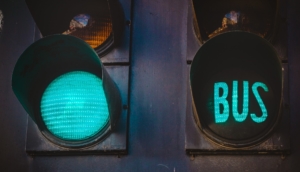We were delighted when we were recently asked by Chris Peat, News Editor at Bus & Coach Buyer, to talk through our new updates to Traffic Light Priority. We had a lot to discuss!
 Read the full feature below, or visit Bus & Coach Buyer to read the article.
Read the full feature below, or visit Bus & Coach Buyer to read the article.
Did you know Ticketer can help get your fleet through traffic lights quicker?
All of the company’s electronic ticketing machines (ETMs) have GPS and regularly report their location. As well as being used to track the fleet, this can also feed into a Strategic Traffic Light Priority (STLP) platform, requesting traffic light priority, meaning traffic lights change to green at the approach of your bus, allowing it to cross the intersection faster.
 International General Manager at Ticketer, Antonio Carmona, explained: “It is able to connect with the traffic control system in an area. Depending on the situation, it will be able to request priority for a vehicle, which generally might be an emergency vehicle, an ambulance taking a patient. But it is also being used for some time now for the prioritisation of public transport.”
International General Manager at Ticketer, Antonio Carmona, explained: “It is able to connect with the traffic control system in an area. Depending on the situation, it will be able to request priority for a vehicle, which generally might be an emergency vehicle, an ambulance taking a patient. But it is also being used for some time now for the prioritisation of public transport.”
Ticketer has been offering this functionality for some time, but it has recently implemented some updates to make it easier to manage. Antonio said: “The way the back office is offering you the functionality to use the system has been improved. We are improving the interface so it is easier to set up the system. For the authorities and operators it is easier to update the configuration, to change what the virtual loops are, how the priority is going to work, what the services are that will be affected and what vehicles are going to be enabled for it. In terms of the basic functionality, it was already all there.”
He reports the Traffic Light Priority capability is gaining more traction every day. He said England’s national bus strategy focuses on how technology can enable a better service. “One of the main technologies that are mentioned across this document is traffic light priorities,” he said.
Rolling Traffic Light Priority out across the fleet obviously requires working with the local authority in charge of traffic lights. Antonio said: “But from the operator running the buses, there is nothing really to be installed. There is no additional hardware, just a configuration done at the back-end and sent across the air to the different devices on buses. This is a software or configuration update.”
There are three ways of bringing about Traffic Light Priority. Firstly, by using electro-magnetic loops that need to be manually installed on-street, involving digging the pavement up. In each bus is an antenna to grant priority. Antonio said: “This is a very complex thing; it’s expensive and takes a lot of time.”
The second method is to use video content analysis, seeing a camera installed on the semaphores, which is used to analyse the vehicle to trigger priority measures.
The third method, and the way Ticketer is able to provide it, is via virtual loops. This involves the creation of a geofence in the back office. When the bus reaches the defined area, it triggers the Traffic Light Priority via a GPS feed.
Antonio said: “I think from the three, the first one was used extensively in the past, but the constraint of having to invest in a lot of capital and then the maintenance is not easy and takes a while. The third one is easy and it’s the fastest, the cheapest and the one with the most benefit. And that’s the one we use.”
“Often it is an unknown technology for local authorities and it is also not really known by operators, especially the simplicity it has. In many cases local authorities are not aware it’s so simple to implement.”
 The benefits of traffic light priority are many, according to Antonio: “For local authorities, it gives better services for citizens. For operators, it not only makes the crossing or intersection faster, but also makes the crossing time more predictable, which helps keep to timetables, bringing more reliability to the public transport system.
The benefits of traffic light priority are many, according to Antonio: “For local authorities, it gives better services for citizens. For operators, it not only makes the crossing or intersection faster, but also makes the crossing time more predictable, which helps keep to timetables, bringing more reliability to the public transport system.
“If you have a vehicle crossing the intersection faster, then you will have a vehicle spending less time polluting the environment. “It is getting more traction every day, because it is a way to incentivise people to use more public transport and less cars.”

